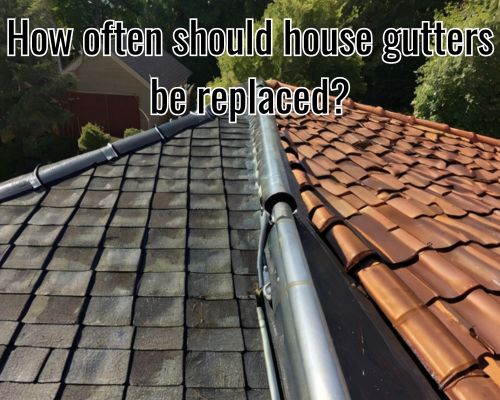Gutters are one of those unsung heroes of your home—quietly channelling rainwater away from your foundation, protecting your walls, landscaping, and even your roof. But in a place like Melbourne, Australia, where rainfall patterns can be erratic and weather conditions swing from searing heat to heavy downpours, knowing when to replace your gutters isn’t just helpful—it’s essential.

So, how often should house gutters be replaced? The short answer: approximately every 20 years. But the reality is more nuanced and depends on several factors including material type, local climate, maintenance routines, and signs of wear and tear. With Gutter Cleaning Melbourne, let’s unpack this in detail.
The Average Lifespan of House Gutters
In Melbourne, homeowners most commonly install aluminium, steel, or colorbond gutters. Each material has a different expected lifespan:
- Aluminium gutters: 20–25 years
- Galvanised steel gutters: 15–20 years
- Colorbond gutters: 25–30 years
- PVC or vinyl gutters (less common in Melbourne): 10–15 years
The lifespan isn’t just a matter of material—it’s a question of installation quality, exposure to environmental elements, and routine cleaning.
Melbourne’s Climate and Its Impact on Gutter Durability
Melbourne’s temperate oceanic climate is known for its “four seasons in a day” temperament. With heavy rainfall in winter, high UV exposure in summer, and leaf litter from local gum trees like the Eucalyptus, gutters in Melbourne are put to the test year-round.
Clogged or rust-prone gutters exposed to frequent debris or fluctuating temperatures can deteriorate faster than their nominal lifespan. If you’re living in leafy suburbs like Kew, Eltham, or Doncaster, your gutters may need more frequent attention—and possibly earlier replacement.
Signs Your Gutters Need Replacing
It’s not always about how long you’ve had your gutters—it’s about how they’re performing. Here are key signs that may indicate a need for gutter replacement rather than repair:
- Sagging or separating gutters
- Rust patches or bubbling paint (especially in steel or Colorbond systems)
- Water pooling near the foundation
- Visible cracks, holes, or splits
- Peeling paint or water stains on exterior walls
- Persistent clogging despite gutter guards or regular cleaning
In older homes across Melbourne’s eastern suburbs, especially those with original 1970s-80s builds, outdated or corroded guttering systems are common—and they often underperform under today’s climate conditions.
Gutter Maintenance: Extend Lifespan Before Replacement
If you’re aiming to squeeze as much life out of your gutters as possible, routine maintenance is non-negotiable. Experts recommend:
- Cleaning gutters at least twice a year (early autumn and late spring in Melbourne)
- Installing gutter guards to reduce blockages from leaves, especially if you’re near native gum or oak trees
- Inspecting joints and brackets annually
- Checking downpipes for clogs and backflow issues
Hiring a professional gutter cleaning service in Melbourne like Gutter Cleaning Melbourne costs between $150 to $300, depending on roof size and access. It’s a small investment that can delay the cost of a full replacement.
Gutter Replacement Costs in Melbourne
If replacement is inevitable, understanding cost is crucial. In 2025, the average cost to replace gutters in Melbourne ranges from $1,500 to $4,000, depending on:
- Linear metres of guttering required
- Material choice (Colorbond is more expensive than PVC)
- Single-storey vs. double-storey homes
- Roof accessibility and pitch
Professional gutter installers often recommend Colorbond for its longevity, aesthetic range, and Australian-made durability. It also complies well with Australian Standards AS/NZS 3500 for plumbing and drainage.
Can You DIY Gutter Replacement?
Technically, yes. Realistically, it’s best left to the pros. Gutter replacement involves:
- Measuring roof perimeter accurately
- Ensuring correct fall to downpipes
- Sealing joins with waterproof compounds
- Working at heights—often with complex roof pitches
In Victoria, some plumbing work is regulated. While gutters may not always require a licensed plumber, insurance claims may be voided if the system fails due to poor DIY installation. It’s why most Melbourne residents opt for licensed roofing contractors.
How Local Regulations Affect Gutter Systems
In Melbourne’s metro and outer suburbs, councils may enforce rules on stormwater discharge, especially in new developments or heritage-listed homes. Council guidelines in areas like Glen Eira or Yarra Ranges might require guttering systems to be connected to rainwater tanks or to manage overflow responsibly.
Checking with your local council or a registered building surveyor can help avoid compliance headaches.
When in Doubt, Get an Inspection
If your gutters are over 15 years old, or if you’ve experienced multiple overflows or minor leaks, it might be time to book a gutter health check. Many Melbourne roofing companies offer free inspections with quotes. Reputable names include:
- Melbourne Gutter Company
- Roofrite
- Gutter Replacement Melbourne VIC
- Bayside Roof Repairs
Look for reviews, public liability insurance, and licensed credentials before hiring.
Conclusion: Don’t Wait for the Rain to Tell You
So, how often should house gutters be replaced? In Melbourne’s weather-wild environment, the practical answer is: every 20 to 25 years, or sooner if your gutters are showing age, damage, or just not performing well. With proper gutter maintenance, strategic upgrades like gutter guards, and attention to local building codes, you can ensure your home’s drainage stays reliable through every storm Melbourne throws your way.
If you’re noticing signs of gutter failure, don’t delay. Catching problems early means a smoother, more affordable transition—before minor drips become major disasters.